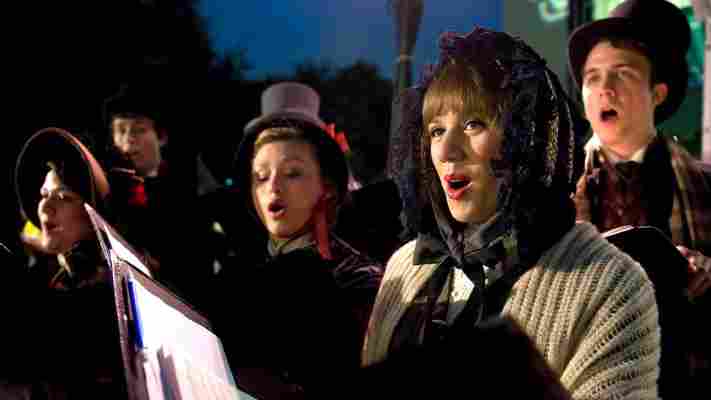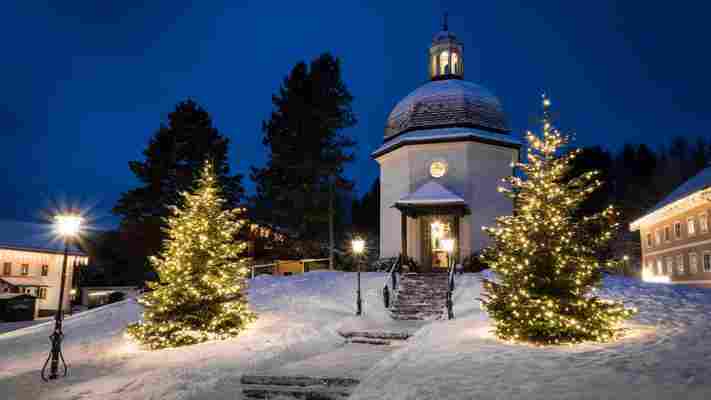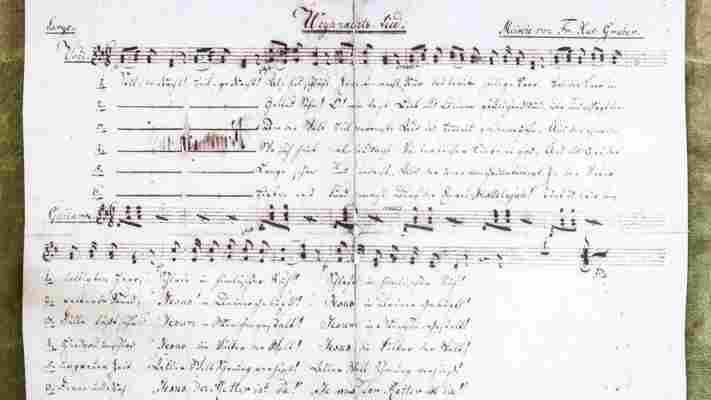Every Christmas Eve, hundreds of people from all over the world crowd outside the octagonal-shaped chapel in Oberndorf, Austria, to sing along to one of the world’s most-beloved Christmas carols: Silent Night.

It’s a scene especially poignant this holiday season
Amid sparkling white lights on a December night, two men, one strumming a guitar, stand in front of the small chapel and sing, in German, Stille Nacht, Heilige Nacht , much like the song was first performed on Christmas Eve in 1818. And then carollers, bundled against the cold, sing the song in various languages.
It’s a scene especially poignant this holiday season, as 24 December 2018 marks the 200th anniversary of the song’s humble origins in Oberndorf.

Every Christmas Eve, hundreds of people gather at the Silent Night Chapel in Obendorf, Austria, to sing Silent Night (Credit: TVB Oberndorf, Stille Nacht Kapelle)
You may also be interested in: • Is this the birthplace of Santa? • What you don’t know about panettone • Spain’s beloved scatological Christmas custom
Silent Night’s bicentennial is being celebrated in Oberndorf and other villages in the province of Salzburg throughout the holiday season. Exhibits in small museums explore the song’s origins and the lives of the two men behind its creation: Joseph Mohr, a priest, and Franz Xaver Gruber, an organist and teacher. A newly designated 1.2km trail winds through Hintersee, a town south-east of Salzburg,exploring Mohr’s life after he left Oberndorf; and in late November, a contemporary Broadway-like production, My Silent Night , premiered at Salzburg’s Felsenreitschule theatre to commemorate the 200th anniversary, concluding its run just before Christmas. The musical includes the famous carol and references the song’s origins.
Over the past two centuries, Silent Night has become a cultural phenomenon, a staple of the Christmas canon in cultures around the globe. The song has been translated into more than 300 languages and dialects, including Latin , and in 2011 was added to the Unesco Intangible Cultural Heritage list . It’s been recorded by countless singers over the decades, everyone from Bing Crosby to Mariah Carey . The song has even inspired peace, if only fleetingly. On Christmas Eve 1914, at the beginning of World War One, soldiers in the trenches on the Flanders front laid down their rifles and helmets and sang Silent Night, among other carols.
Christmas might be the most obvious time of the year to trace the roots of Silent Night and enjoy the festivities in and around Salzburg, a city rich in culture and musical history, with ties to Mozart and the von Trapp Family Singers, the inspiration for the beloved musical, The Sound of Music. More than one million visitors are expected during the anniversary in November and December, according to Leo Bauernberger, CEO of the Salzburg State Board of Tourism , although many of the Silent Night sites are open year-round.
“As much as we have lived with Silent Night in Salzburgerland, it has taken a long time to raise awareness and pride in this unique Alpine cultural treasure,” Bauernberger said. “The anniversary is thus the perfect occasion for us to take this newly created consciousness out to people all over the world and bring them closer to the history and roots of Silent Night, Holy Night.”
While the lives of the men behind Silent Night can be explored in several villages where they lived or worked, the song’s beginnings truly lie in Oberndorf, a small village on the Salzach River, about 20km north of Salzburg.

This year marks the 200th anniversary of Silent Night (Credit: SalzburgerLand Tourismus)
On Christmas Eve in 1818, Mohr, assigned to the newly established parish of St Nicholas, asked his friend, Gruber, to compose a melody to a poem he had written two years earlier. Happy with the results, Mohr included the song in a short ceremony following Christmas Mass that same evening.
Mohr sang tenor and strummed along on guitar, while Gruber sang bass, before a congregation of boat builders, labourers and others.
What inspired Mohr to write the poem is unknown. In a historic letter by Gruber, Authentic Account of the Origin of the Christmas Carol, Silent Night, Holy Night, there is no mention of the specific reason. Gruber, though, does recount the request he received that day from Mohr to “write a fitting melody for two solo voices together with choir and for accompaniment by guitar.”
Michael Neureiter, president of the Silent Night Association and co-editor of a newly released book, Silent Night: A Companion to the Song, speculates inspiration may have come from the yearning for continued peace in the wake of the Napoleonic Wars, which raged from 1803 to 1815 and caused economic and other hardships in the region. Around that time, Europe also experienced the ‘Year Without A Summer’ , months of colder-than-normal weather in 1816 that led to crop failures and famine, caused by a volcanic eruption in Indonesia the previous year.
Since it was first performed in 1818, Silent Night has become one of the world’s most beloved Christmas carols (Credit: Cultura Creative (RF)/Alamy)
How Silent Night was received by the Oberndorf congregation that first night is unknown. Gruber, in a later account, only noted that the song received approval. And it’s not known whether the song was performed on subsequent Christmas Eves.
“We don’t know how people reacted,” said Neureiter, who holds a special bond to the song’s composer: he grew up in the house in Hallein where Gruber spent the last years of his life, pursuing his passion for music. The house is now a museum whose collection includes Mohr’s guitar and hand-written documents about the song’s authorship. Gruber’s final resting place lies in front of the building.
In Oberndorf, the original church is long gone, razed in the early 20th Century after frequent flooding damaged the structure. A memorial chapel was built in its placein the 1930s, and this is where the beloved song is performed at 17:00 every Christmas Eve, as it has been since 1953.
Silent Night has been translated into more than 300 languages and dialects (Credit: Digital First Media/Orange County Register/Getty Images)
The original vicarage next to the chapel is home to the Silent Night Museum Oberndorf . The museum relates the song’s story in the context of the era in which it was created. By Christmas Eve 1818, Oberndorf had settled into peace following the end of the Napoleonic Wars, struggling to find everyday normalcy against new political boundaries and disruption of the salt trade, the backbone of the region’s economy.
Whatever the true story behind Mohr’s poem, the simple melody and message of peace resonated
Mohr wrote the poem while serving as an assistant priest in a nearby village, Mariapfarr, also home to a Silent Night Museum that is noteworthy for a large nativity scene comprised of 100 figurines that dates from 1750 and was in use when Mohr served the village. A panel painting in the church, Worship of the Three Kings and the Golden Boy with Curly Hair, which depicts the visit of the Wise Men after Jesus’ birth, may have inspired some words in Mohr’s poem. One line in particular – ‘Holy infant, so tender and mild’ – reminds visitors of the curly blonde baby Jesus in the painting.
Whatever the true story behind Mohr’s poem, the simple melody and message of peace resonated with those who heard it, and Silent Night’s journey around the world began slowly.
A few years after that first performance, a man who came to repair the organ at the Oberndorf chapel took a copy of the Silent Night score with him. The song reached another village, Tirol, about 165km south-west of Oberndorf, where local farm families passed the winter selling their goods at markets and fairs. Sometimes they would sing local folk songs to draw attention to their wares. Over time, some of these families became famous as folk singers, notably the Rainer and Strasser families, performing in Germany as well as other parts of Europe and Russia. Missionaries and German immigrants also extended the song’s reach to Great Britain and the US and beyond.
Austria is home to a number of museums dedicated to telling the story of Silent Night (Credit: Still Nacht – Tirol Werbung GmbH)
In Salzburg, Mohr’s birthplace, a multimedia exhibit at the Salzburg Museum, Silent Night 200 – The Story. The Message. The Present , explores the story of the carol and its impact on the world with sound recordings, artefacts and historical documents. Highlights include a moving installation dubbed ‘Morphing’, in which several screens display men and women of different origins and ages singing Silent Night. Every two beats, the singers morph into another person, in a different voice and language. Visitors can also watch a choir comprised solely of hearing-impaired singers interpret the song in sign language.
“It’s an extremely emotional interpretation, but also a remarkable demonstration of the song’s universality,” said Natalie Fuchs, a spokeswoman for the Salzburg Museum , which expects the typical number of 100,000 annual visitors to skyrocket this year.
It’s an extremely emotional interpretation
While Fuchs understands the song’s timeless appeal and its message of peace, she believes Silent Night connects with many people on a more emotional level, one with ties to the celebration of Christmas with families and friends over the years.
“Odours, dishes, decorations all focus on that silent and holy night,” she said. “As adults, it is those seemingly minor aspects, such as a simple song like Silent Night, Holy Night, that remind us of these emotions we experienced so deeply as children.”
Join more than three million BBC Travel fans by liking us on Facebook , or follow us on Twitter and Instagram .
If you liked this story, sign up for the weekly bbc.com features newsletter called "If You Only Read 6 Things This Week". A handpicked selection of stories from BBC Future, Culture, Capital and Travel, delivered to your inbox every Friday.
